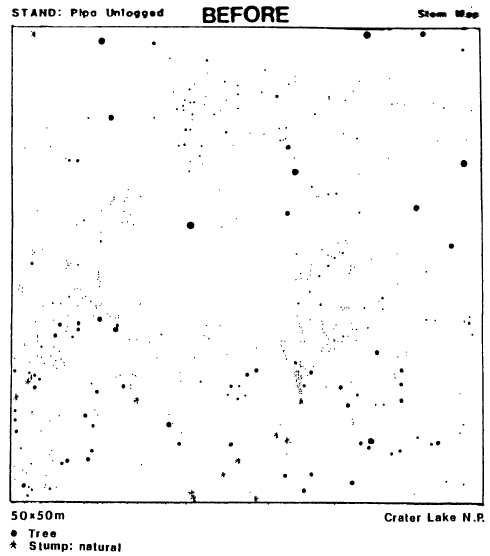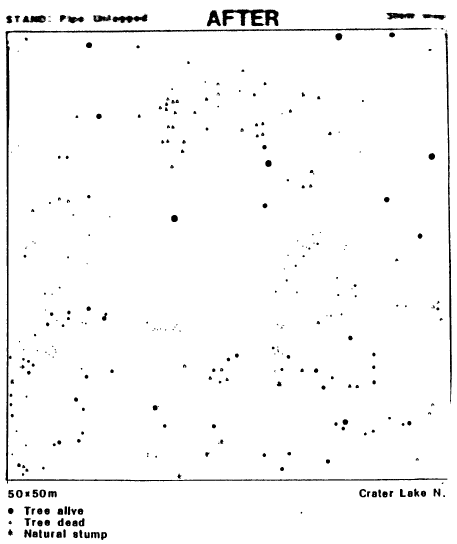Final Report, Forest Restoration of Sun Creek, Crater Lake National Park
Research Summary
Forest Structure
Several forest structure characteristics were measured; species composition, tree density, diameter, age, and height distributions. Most of the analyses considered only those trees greater than 5.5 cm dbh, but height analyses considered all trees. Since many of the fire impacts are on smaller diameter, younger, shorter trees, the density, diameter, and age analyses should be interpreted with this in mind.
Forest density (trees greater than 5.5 cm dbh) was high before the fire. The sugar pine plots (per hectare) had more variations (312 unlogged, 964 logged) then ponderosa pine plots (672 unlogged, 692 logged). Most of the mortality due to the fire was in white fir (Table 2). Trees less than 5.5 cm dbh were analyzed as a species undifferentiated group, and mortality ranged from 66 to 95 percent. A map of one 50 x 50 m plot before and after burning illustrates the effects of the fire on forest density (Figure 3).
|
Sugar Pine Plots |
Ponderosa Pine Plots |
||||
|
Unlogged |
Logged |
Unlogged |
Logged |
||
| Ponderosa Pine | 0 | 9.1 | 8.3 | 0 | |
| Sugar Pine | 2.5 | 23.1 | 36.2 | 0 | |
| White Fir | 25.4 | 30.0 | 36.2 | 40.4 | |
| Table 2. Percent mortality by species on each burned plot (trees above 5.5 cm dbh only). | |||||
Diameter analyses were done only for those trees above 5.5 cm dbh. Excluding the smaller trees, significant differences (p < .01) in mortality between diameter classes were found on the sugar pine logged plot, the ponderosa unlogged plot, and for all plots combined. This was due to higher mortality in the smaller diameter classes. As shown by Figure 4, white fir showed the most mortality and also showed some mortality in trees up to 110 cm diameter.
Age analyses showed that younger trees tend to suffer more mortality than older trees. However, there was mortality in all age classes of white fir on the sugar pine unlogged plot and the ponderosa pine logged plot. One of the more intriguing results of the age analysis was that white fir began to “invade” the vicinity of the ponderosa pine plots 180-200 years ago. Climatic factors do not appear to be responsible for this invasion, which occurred 80-100 years before possible fire suppression. However, the invasion period is coincident with a fire-free period between 1797 and 1829 in the panhandle area (McNeil and Zobel, 1980) which may have allowed fir to establish some fire resistance before fire again passed through the area.
 |
 |
| Figure 3. Stem map of unlogged ponderosa pine plot before and after burning. Most of the stem reductions are in the smaller diameter classes. |
The height analyses were done on two groups of trees: those less and greater than 5.5 cm dbh. In the smaller trees, mortality ranged from 75 to 87 percent; mortality was similar for trees in the 0-1 m and 1-10 m height classes. For the larger diameter trees, taller height classes had significantly less mortality (Figure 5). Again, white fir appeared to be more susceptible in most height classes than the pines.
***previous*** — ***next***

